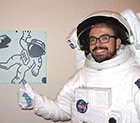Teachable Moment .
.2 min readGravitational Waves Detected for the First Time
The collision of two black holes 1.3 billion years ago (as shown in this animation) produced gravitational waves that were detected for the first time by researchers at the Laser Interferometer Gravitational-Wave Observatory (LIGO) on September 14, 2015.
Update – Oct. 3, 2017: Researchers Kip Thorne and Barry Barish of Caltech and Rainer Weiss of MIT have been awarded the 2017 Nobel Prize in Physics for their “decisive contributions to the LIGO detector and the observation of gravitational waves.”
Thorne, Barish and Weiss played key roles in making the LIGO project a reality through their research, leadership and development of technology to detect gravitational waves.
In a statement to Caltech, Thorne said the prize also belongs to the more than 1,000 scientists and engineers around the world who play a part on LIGO, the result of a long-term partnership between Caltech, MIT and the National Science Foundation.
Read the Caltech press release
This story was originally published on March 23, 2016.
In the News
A century ago, Albert Einstein theorized that when objects move through space they create waves in spacetime around them. These gravitational waves move outward, like ripples from a stone moving across the surface of a pond. Little did he know that 1.3 billion years earlier, two massive black holes collided. The collision released massive amounts of energy in a fraction of a second (about 50 times as luminous as all the stars in the visible universe combined) and sent gravitational waves in all directions. On September 14, 2015 those waves reached Earth and were detected by researchers at the Laser Interferometer Gravitational-Wave Observatory (LIGO).
Why It's Important
Einstein published the Theory of General Relativity in 1915. In it, he predicted the existence of gravitational waves, which had never been directly detected until now. In 1974, physicists discovered that two neutron stars orbiting each other were getting closer in a way that matched Einstein’s predictions. But it wasn’t until 2015, when LIGO’s instruments were upgraded and became more sensitive, that they were able to detect the presence of actual gravitational waves, confirming the last important piece of Einstein’s theory.
It's also important because gravitational waves carry information about their inception and about the fundamental properties of gravity that can’t be seen through observations of the electromagnetic spectrum. Thanks to LIGO’s discovery, a new field of science has been born: gravitational wave astronomy.
How They Did It
LIGO consists of facilities in Washington and Louisiana. Each observatory uses a laser beam that is split and sent down 2.5-mile (4-kilometer) long tubes. The laser beams precisely indicate the distance between mirrors placed at the ends of each tube. When a gravitational wave passes by, the mirrors move a tiny amount, which changes the distance between them. LIGO is so sensitive that it can detect a change smaller than 1/10,000 the width of a proton (10-19 meter). Having two observatories placed a great distance apart allows researchers to approximate the direction the waves are coming from and confirm that the signal is coming from space rather than something nearby (such as a heavy truck or an earthquake).
Teach It
Creating a model that demonstrates gravitational waves traveling through spacetime is as simple as making a gelatin universe!
Middle school students can develop a model that shows gravitational waves traveling through spacetime while working toward the following Next Generation Science Standard:
- MS-PS4-2 - Develop and use a model to describe that waves are reflected, absorbed, or transmitted through various materials.
Explore More
About the Author

Lyle Tavernier
Educational Technology Specialist, NASA-JPL Education Office
Teachable Moment Last Updated: Oct. 11, 2024